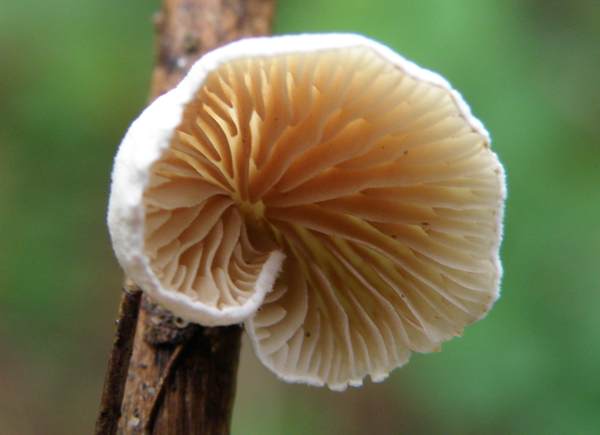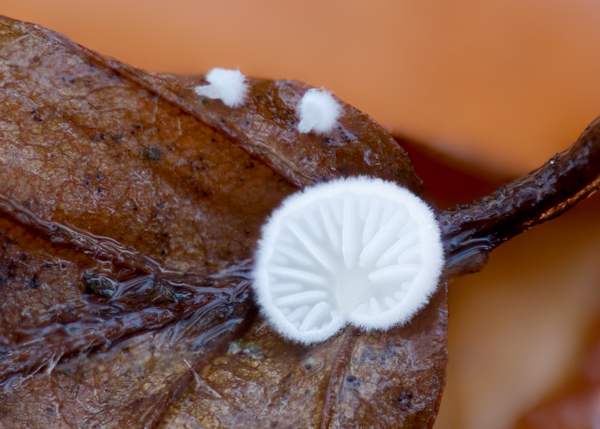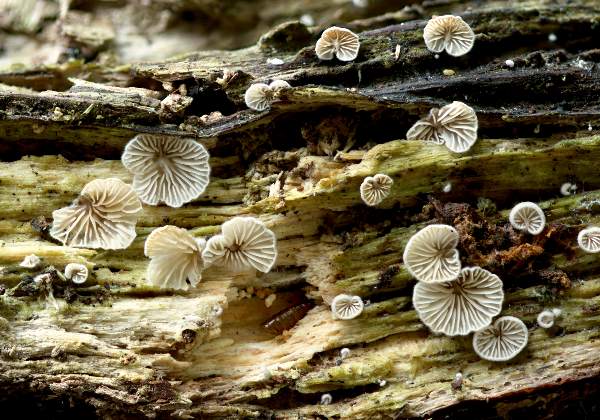Crepidotus epibryus (Fr.) Quél. - Grass Oysterling
Phylum: Basidiomycota - Class: Agaricomycetes - Order: Agaricales - Family: Inocybaceae
Distribution - Taxonomic History - Etymology - Culinary Notes - Identification - Reference Sources
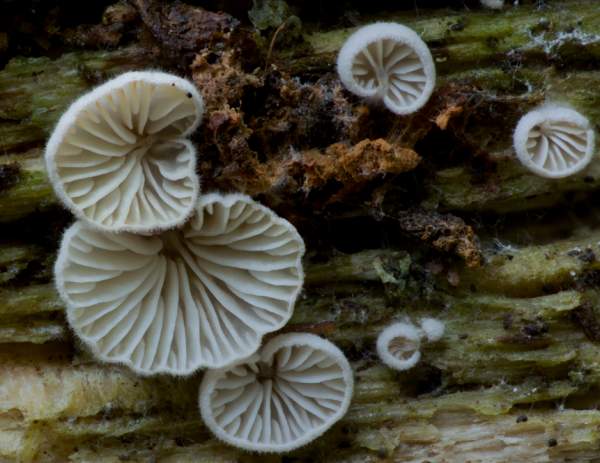
Even smaller than the Variable Oysterling, Crepidotus variabilis, this pretty little mushroom is widespread and very common in woodlands, particularly where bracken encroaches from the edges of forestry tracks.
Growing on deciduous hardwood twigs and occasionally on dead leaves, this is also a fairly common find on the dead stems of bracken and other herbaceous plants in woodlands and on heathland.
Distribution
Common in most parts of Britain and Ireland, this mushroom occurs across mainland Europe and is also recorded in many other parts of the world including North America.
Taxonomic history
Elias Magnus Fries, the great Swedish mycologist, described this little oysterling in 1821, creating its basionym when he gave it the binomial scientific name Agaricus epibryus. French mycologist Lucien Quélet transferred this species to the genus Crepidotus in 1888, whereupon it acquired its currently accepted scientific name Crepidotus epibryus.
In a couple of centuries this little mushroom has accumulated a vast list of synonyms among which are Agaricus epibryus Fr., Agaricus variabilis var. hypnophilus Pers., Agaricus hypnophilus (Pers.) Berk., Agaricus herbarum Peck, Crepidotus herbarum (Peck) Sacc., Pleurotus hypnophilus (Pers.) Sacc., Pleurotellus hypnophilus (Pers.) Fayod, Pleurotellus graminicola Fayod, Crepidotus commixtus Bres., Pleurotus commixtus (Bres.) Bres., Dochmiopus commixtus (Bres.) Singer, and Pleurotellus herbarum (Peck) Singer.
Etymology
The generic name Crepidotus comes from crepid- meaning a base, such as a shoe or a slipper (although some sources state that it means 'cracked'), and otus, meaning an ear - hence it suggests a 'slipper-like ear'. In the past mushrooms in this genus were sometimes referred to as slipper mushrooms. The specific epithet epibryus is obscure to me. The prefix epi- means from an axis and is probably a reference to the way these caps grow from the infertile side of the cap. Any suggestions?
Identification guide
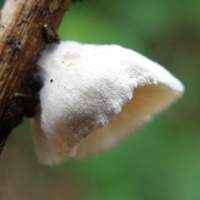 |
Cap0.4 to 1.5cm across, convex kidney-shaped fan flattening somewhat but retaining an inrolled margin; upper surface white or pale buff and finely felted; laterally attached or attached by its ‘back’ to the substrate. |
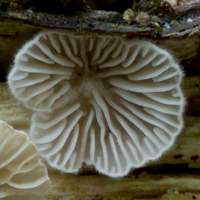 |
GillsCrowded; white becoming pinkish brown, radiating from point of attachment. StemUsually there is no visible stipe, as the attachment to the substrate is near the centre of the cap on its infertile (nominally 'upper') surface.. |
SporesEllipsoidal, smooth 7-9 x 3-3.5µm. Spore printPale buff. |
|
Odour/taste |
Not distinctive. |
Habitat & Ecological role |
On dead leaves and rotting wood, especially on the stems of dead grass and bracken. |
Season |
Late summer and autumn. |
Similar species |
Crepidotus variabilis is typically larger, does not have an inrolled margin, and has a smoother cap surface. |
Culinary Notes
This uncommon summer and autumn species is of dubious edibility and may even be poisonous. Many authorities give this genus family status as Crepidotaceae, while others include the genus Crepidotus within the family Inocybaceae; this should be a warning that these little fungi are not for eating, as some Inocybe species are deadly poisonous. Care is needed, therefore, when collecting edible Oyster Mushrooms, Pleurotus ostreatus, to avoid accidentally gathering Crepidotus epibryus instead. The pale ochre spore print of this oysterling (and in most instances its much smaller size) readily distinguishes it from edible Oyster Mushrooms, whose spore prints are white.
Reference Sources
Pat O'Reilly; Fascinated by Fungi, second edition, 2016.
Dictionary of the Fungi; Paul M. Kirk, Paul F. Cannon, David W. Minter and J. A. Stalpers; CABI, 2008
Taxonomic history and synonym information on these pages is drawn from many sources but in particular from the British Mycological Society's GB Checklist of Fungi.
Acknowledgements
This page includes pictures kindly contributed by David Kelly.
Fascinated by Fungi. Back by popular demand, Pat O'Reilly's best-selling 450-page hardback book is available now. The latest second edition was republished with a sparkling new cover design in September 2022 by Coch-y-Bonddu Books. Full details and copies are available from the publisher's online bookshop...
